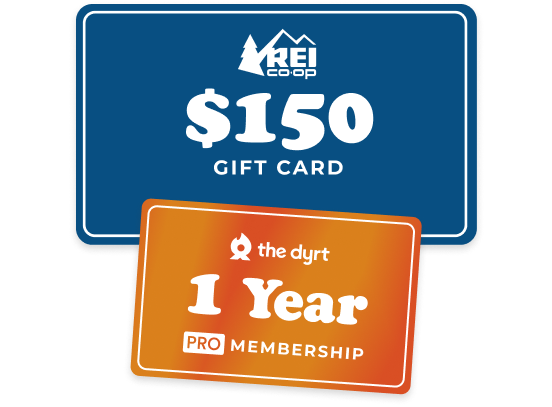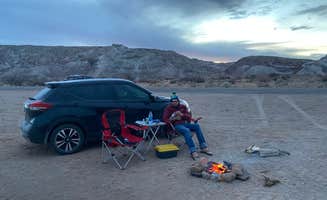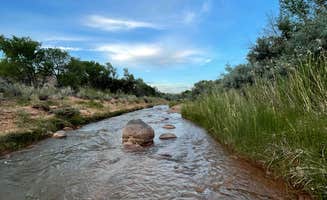Dispersed camping areas around Hanksville, Utah provide primitive overnight options in the desert landscape between Capitol Reef and Goblin Valley State Park. The region sits at approximately 4,300 feet elevation with dramatic sandstone formations and expanses of slickrock. Summer temperatures regularly exceed 100°F, while winter nights can drop below freezing with occasional snow.
What to do
Explore slot canyons: Take a short drive to Little Wild Horse Canyon, which offers accessible hiking through narrow passages. "Great access to slot canyon hikes and so much to explore. Will return," notes Cooper A., who camped at the nearby San Rafael Swell.
Visit desert overlooks: Drive to Moonscape Overlook for sunset photography. "Incredible views at sunrise and sunset, be prepared for lots of people during those times. Otherwise it was fairly quiet and we were one of three small groups camping overnight at the edge of the cliffs," advises Brian P.
Rock climbing: The San Rafael Swell area offers routes for various skill levels. "This is a great place to wander primitive unspoiled deserts! Nearby there is committing trad and sport climbs as well as difficult canyoneering routes," explains Alan B., who found Goblin Valley dispersed sites perfect for accessing climbing areas.
What campers like
Rock formations: Many campers select sites nestled against unique rock formations. "We found a great space tucked into the cliffs that provide privacy, space for the kids to explore and play for hours on end, and enough space that we could spread out our camp," writes Jeff H. about his family's experience camping near Goblin Valley.
Dark night skies: The remote location offers exceptional stargazing. "Stars were awesome," noted Mark R. at Temple Mountain Road, though he also claimed to see what he believed were UFOs parading through the sky during his stay.
Sense of solitude: Many sites offer privacy despite their accessibility. "Wow total solitude," writes Francois T. about his experience at Goblin Valley Dispersed Camping, adding "Loved it, but man was it hot and windy but as soon as the sun begins to set its magic."
What you should know
Road conditions vary: Many access roads require careful driving. "The dirt road to the sites was in good condition and no problem for Tahoe pulling 24 ft camper," notes suzie about the East Dispersed Area near Goblin Valley. However, other areas may require high clearance vehicles.
Prepare for wind: The open landscape offers little protection from weather. "It was very windy during our visit with wind whipping down the canyon," reports Barbara L. about Temple Mountain Road.
Water access: The Goblin Valley State Park entrance station has limited services. "You can fill and dump camper at goblin valley state park but it is not free," notes A D., who stayed at the East Dispersed Area.
Cell service limitations: Coverage varies by location. "No cell service from any carrier, and our cell booster did not help," reports Laura M. about the East Dispersed Area.
Tips for camping with families
Choose protected sites: Find locations with natural rock barriers to block wind. "We settled in a cottonwood grove along the road past the Ding Dang trailhead," suggests Cooper A., who visited the San Rafael Swell area with his family.
Provide exploration space: Many sites offer natural playground areas. "It was very calm during our visit, not windy at all. Easy road in for our ProMaster with very level spots. Part of it looks like an old asphalt runway," writes James M. about the BLM Mix Pad area near Cathedral Valley.
Plan for temperature swings: Desert temperatures change dramatically between day and night. "We went in the middle of October and it was 40° at night and 75° during the day so we were pretty cold at night but pretty hot during the day," reports Jamie, who found sites west of Goblin Valley State Park better than the paid campground.
Tips from RVers
Site selection for larger rigs: Many areas can accommodate RVs with proper access roads. "Multiple sites throughout the recreation area easily accessible for big rigs! Parked 2 40+ ft. rigs near the highway and went in to explore," shares REBECCA about Temple Mountain Road dispersed camping.
Consider wind exposure: RVs are particularly vulnerable to high winds. "High winds can be an issue, but we enjoyed the experience," adds REBECCA about rustic camping near Hanksville.
Road navigation: Take time navigating dirt access roads. "If you're looking for that 'je ne sais quoi' spot, then you'll have to drive off the dirt trails off of Wild Horse Rd. It was well worth it. The rock formations provide a secluded and 'out of this world' experience. I have a 24' travel trailer and the off road section is bumpy, but if you take your time, you can certainly do it," advises Steven M.













